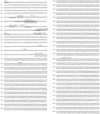Discovery of a novel murine type C retrovirus by data mining
- PMID: 11222735
- PMCID: PMC115936
- DOI: 10.1128/JVI.75.6.3053-3057.2001
Discovery of a novel murine type C retrovirus by data mining
Abstract
Analysis of genomic and expression data allows both identification and characterization of novel retroviruses. We describe a recombinant type C murine retrovirus, similar to the Mus dunni endogenous retrovirus, with VL30-like long terminal repeats and murine leukemia virus-like coding sequences. This virus is present in multiple copies in the mouse genome and expressed in a range of mouse tissues.
Figures




References
MeSH terms
Associated data
- Actions
- Actions
- Actions
- Actions
- Actions
- Actions
- Actions
- Actions
LinkOut - more resources
Full Text Sources

